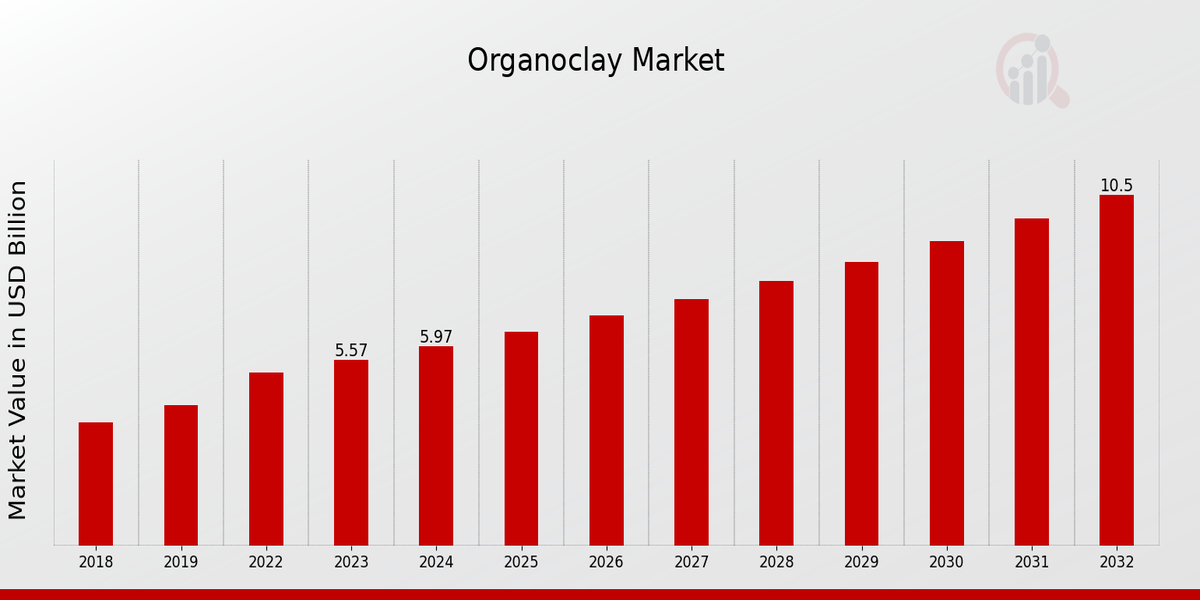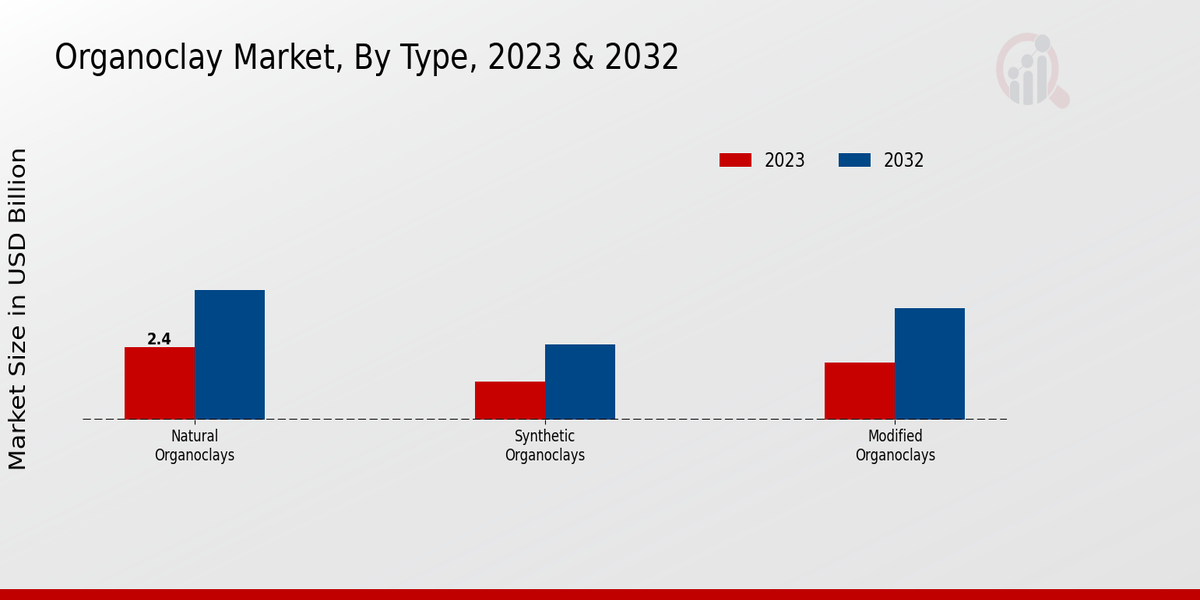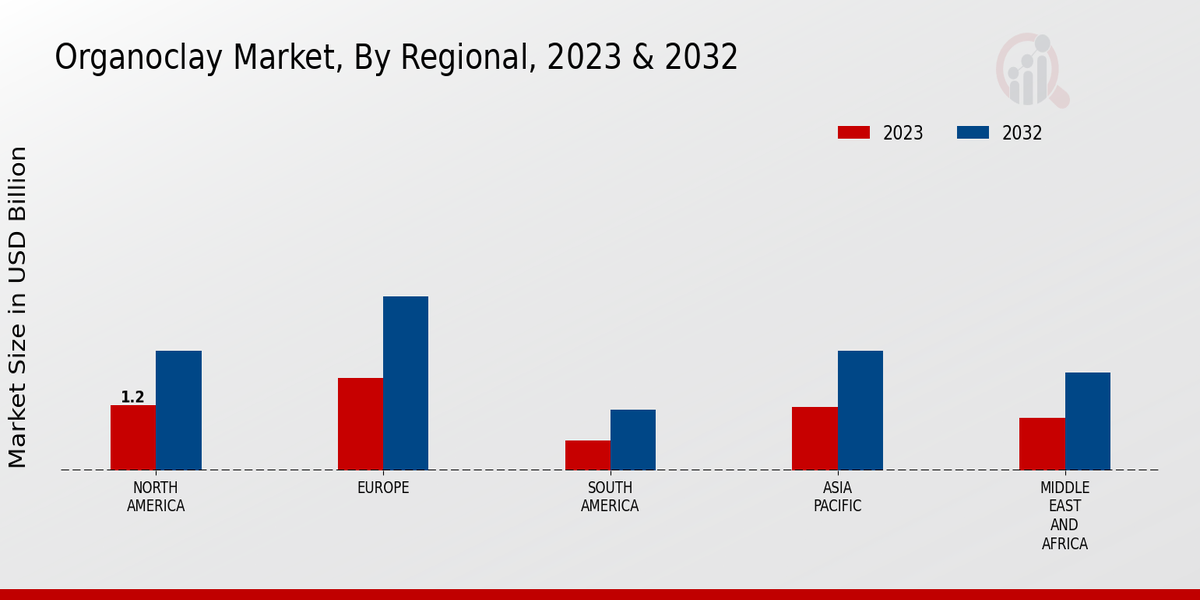Global Organoclay Market Overview
The Organoclay Market Size was estimated at 6.42(USD Billion) in 2024. The Organoclay Industry is expected to grow from 6.88(USD Billion) in 2025 to 13(USD Billion) by 2034. The Organoclay Market CAGR (growth rate) is expected to be around 7.3% during the forecast period (2025 - 2034).
Key Organoclay Market Trends Highlighted
Growing need for high-performance materials across automotive and aerospace industries, electronics and other sectors is one of the key contributing factors for the organoclay market. Due to the superior mechanical strength and thermal resistance and barrier characteristics organoclays are incorporated into lightweight composites, flame retardants and packing materials.
The organoclay industry is expected to grow with the development of sustainable and compostable organoclays. Due to rising concerns and restrictions using synthetic materials, the demand for green organoclays has been on the rise. Besides, the increasing uptake of organoclays in developing regions especially Asia Pacific provides a ripe opportunity for growth.
Some of the current developments in the organoclay market include the advent of more industrial efficient processes such as nano blending and surface modification. These processes help improvise the organoclays such that they can be customized to meet the demands of particular applications. There is also a growing trend in opportunities of using organoclays in functional coatings and composites as the demands for high durability, corrosion resistance and better thermal management materials increase.

Source Primary Research, Secondary Research, MRFR Database and Analyst Review
Organoclay Market Driver
Rising Demand for Organoclay in Polymer Composites
The polymer composites market is expected to be valued at USD 150 billion by 2025. The market demand is primarily driven by the increasing use of polymer composites across various end-use industries, such as automotive, construction, and consumer electronics. One of the most frequently employed reinforcement agents in polymer composites is organoclay, being used in order to enhance the mechanical properties, thermal stability, and fire resistance of such materials.The development of polymer composites that are low-weight and, at the same time, high-performing is expected to cause a significant rise in the demand for organoclay in the forecast period. The agent also enhances the performance of polymers in several other ways increasing their material strength, stiffness as well as toughness. Additionally, organoclay serves as a fire retardant for flammable polymer materials. The composite materials are becoming ever more widespread in a number of applications and the ever-increasing demand for lightweight, high-performing materials is expected to remain a significant factor in the growth tendency of the organoclay market over the forecast period.
Growing Adoption of Organoclay in Coatings and Paints
The coatings and paints market is anticipated to reach USD 200 billion by 2025, attributed to the increasing demand in the construction, automotive, and industrial sectors. In the coatings and paints, organoclay is increasingly being used as a rheology modifier that enhances flow and leveling properties. Moreover, it improves the barrier properties of coatings, protecting against moisture, corrosion, and chemicals. The rising demand from coatings and paints to offer high performance along with the increasing utilization of organoclay as a functional additive are the factors projected to drive the organoclay market within the coatings and paints industry.
Increasing Environmental Regulations and Sustainability Concerns
Governments worldwide are implementing stringent environmental regulations to reduce the impact of industrial activities on the environment. Organoclay is considered an environmentally friendly material as it is derived from natural clay minerals and does not pose any significant environmental hazards. The growing emphasis on sustainability and the adoption of eco-friendly materials in various industries are expected to drive the demand for organoclay in the coming years.
Organoclay Market Segment Insights
Organoclay Market Type Insights
The Organoclay Market segmentation by Type comprises Natural Organoclays, Synthetic Organoclays, and Modified Organoclays. Among these, Natural Organoclays held the largest market share in 2023 and are projected to continue their dominance during the forecast period due to their advantages such as high adsorption capacity, low cost, and eco-friendliness. The increasing demand for natural and organic products in various industries is driving the growth of the Natural Organoclays segment. Synthetic Organoclays are expected to witness significant growth in the coming years due to their superior properties such as higher thermal stability, better mechanical strength, and tailored surface chemistry.They find applications in high-performance composites, coatings, and plastics. Modified Organoclays are gaining traction in the market owing to their ability to enhance the properties of natural and synthetic organoclays. By modifying the surface chemistry or structure of organoclays, manufacturers can tailor their performance to meet specific application requirements. This segment is anticipated to grow at a steady pace during the forecast period. The Organoclay Market revenue for Type segment is expected to reach USD 6.7 billion by 2024, expanding at a CAGR of 7.5% from 2023 to 2032.The rising demand for organoclays in various industries, including oil gas, paints coatings, plastics, and rubber, is fueling the growth of the market. The increasing adoption of organoclays in environmental applications, such as wastewater treatment and soil remediation, is also contributing to the market growth.

Source Primary Research, Secondary Research, MRFR Database and Analyst Review
Organoclay Market Application Insights
One of the most influential segments of the Organoclay Market is its application, which shapes the market growth as a whole and impacts dynamic trends. Most prominently, as of 2023, polymers and plastics are the key applications, representing an approximate market size of 2.2 billion USD. The growth in this industry is mainly because the demand for organoclays continues to grow due to their use as an additive to act as a reinforcing agent and a flame retardant in various polymer-based items. Paints and coatings are another essential application, with an estimated value of 1.5 billion USD.This sector experiences growth as the use of organoclays in paints and coatings enhances such qualities as barrier resistance, UV protection, and adhesion. The next substantial application of organoclays is in the oil and gas industry, for the development of drilling fluids and sealants, contributing to a market size of 1.2 billion USD. Finally, the automotive industry uses these additives in numerous applications, such as various parts such as interior components and most under-the-hood parts, contributing to an approximate market size of 0.9 billion USD.Additionally, organoclays are used in pharmaceuticals, cosmetics, and other industries, with a collective market size of 1.7 billion USD.
Organoclay Market Source Insights
The source segment plays a crucial role in the Organoclay Market segmentation. Montmorillonite is projected to hold the largest market share, driven by its extensive use in various industries, including oil and gas, paints and coatings, and plastics. In 2023, the Organoclay Market revenue from Montmorillonite is estimated to be around 2.5 billion USD, and it is expected to grow at a CAGR of 7.5% during the forecast period. Hectorite is another significant source, with a market share of approximately 20%. It finds applications in the automotive and pharmaceutical industries.Saponite and Nontronite are also important sources, with a combined market share of around 15%. These sources are primarily used in the ceramics and construction industries. The Organoclay Market data suggests that the demand for organoclay from various sources is influenced by factors such as product performance, cost-effectiveness, and environmental regulations.
Organoclay Market Regional Insights
The regional segmentation of the Organoclay Market showcases a diverse landscape with varying market dynamics. North America holds a significant share of the market, driven by the presence of major oil and gas exploration activities and a growing demand for organoclays in the automotive industry. Europe follows closely behind, with a well-established chemical industry and increasing adoption of organoclays in various applications. The Asia-Pacific region is expected to witness substantial growth in the coming years, attributed to the rapid industrialization and urbanization in countries like China and India.South America and the Middle East and Africa (MEA) regions also contribute to the market, with MEA showing promising growth potential due to increasing investments in infrastructure and construction. These regional insights provide valuable information for businesses seeking to expand their presence or tailor their strategies to specific geographic markets.

Source Primary Research, Secondary Research, MRFR Database and Analyst Review
Organoclay Market Key Players and Competitive Insights
Major players in the Organoclay Market industry are constantly investing in research and development to improve their product offerings and gain a competitive edge. Leading Organoclay Market players are focusing on developing innovative products that meet the evolving needs of customers. The Organoclay Market is characterized by intense competition, with key players adopting various strategies to strengthen their market position. Strategic partnerships, mergers, and acquisitions are common strategies employed by companies to expand their product portfolio and geographical reach. Market development initiatives, such as product launches and capacity expansions, are also undertaken by companies to cater to the growing demand for organoclays.A leading company in the Organoclay Market, Bentonite Performance Minerals, is known for its innovative product offerings and customer-centric approach. The company's commitment to quality and sustainability has earned it a strong reputation in the industry. Bentonite Performance Minerals has a presence and caters to a diverse range of industries, including automotive, construction, and agriculture. The company's focus on research and development has resulted in the development of advanced organoclay products that meet the specific requirements of its customers.A significant competitor in the Organoclay Market, BYK Additives Instruments, is recognized for its expertise in the field of additives and instruments. The company offers a comprehensive range of organoclays that are used in various applications, including coatings, plastics, and personal care products. BYK Additives Instruments emphasizes innovation and technical support, providing customers with tailored solutions to meet their specific needs. The company's presence and strong distribution network enable it to effectively serve customers around the world. BYK Additives Instruments is committed to driving the development of the Organoclay Market through its advanced products and technical expertise.
Key Companies in the Organoclay Market Include
- Tolsa Group
- Elementis
- Imerys
- Nanocor
- BASF
- ECC Group
- Arkema
- BYK Additives Instruments
- Vanderbilt Minerals
- Luzenac
- Clariant
- Southern Clay Products
- NANOCAutomotive Technologies
- Kunimine Industries
Organoclay Market Industry Developments
The Organoclay Market is projected to reach USD 10.5 billion by 2032, exhibiting a CAGR of 7.3% during the forecast period (2024-2032). Rising demand for organoclay in various industries, including plastics, coatings, and personal care, is driving market growth. The increasing adoption of organoclays as rheology modifiers and reinforcing agents in plastics is a major factor contributing to market expansion. Additionally, growing environmental concerns and the need for sustainable materials are propelling the demand for organoclays as eco-friendly alternatives to traditional materials. Key industry players are focusing on product innovation and strategic partnerships to cater to the evolving needs of end-use industries.
Organoclay Market Segmentation Insights
- Organoclay Market Type Outlook
- Natural Organoclays
- Synthetic Organoclays
- Modified Organoclays
- Organoclay Market Application Outlook
- Polymers and Plastics
- Paints and Coatings
- Oil and Gas
- Automotive
- Pharmaceuticals
- Cosmetics
- Organoclay Market Source Outlook
- Montmorillonite
- Hectorite
- Saponite
- Nontronite
- Organoclay Market Regional Outlook
- North America
- Europe
- South America
- Asia Pacific
- Middle East and Africa
| Report Attribute/Metric |
Details |
| Market Size 2024 |
6.42(USD Billion) |
| Market Size 2025 |
6.88(USD Billion) |
| Market Size 2034 |
13(USD Billion) |
| Compound Annual Growth Rate (CAGR) |
7.30% (2025 - 2034) |
| Report Coverage |
Revenue Forecast, Competitive Landscape, Growth Factors, and Trends |
| Base Year |
2024 |
| Market Forecast Period |
2025 - 2034 |
| Historical Data |
2020 - 2024 |
| Market Forecast Units |
USD Billion |
| Key Companies Profiled |
Tolsa Group, Elementis, Imerys, Nanocor, BASF, ECC Group ,Arkema ,BYK Additives Instruments ,Vanderbilt Minerals ,Luzenac ,Clariant ,Southern Clay Products ,NANOCAutomotive Technologies ,Kunimine Industries |
| Segments Covered |
Type, Application, Source, Regional |
| Key Market Opportunities |
Growing demand for rheology modifiers in construction Paints amp coatings and paper Increasing use in polymer composites Potential in oil and gas drilling fluids Rising adoption in personal care amp cosmetics |
| Key Market Dynamics |
Increasing automotive production Growing plastics industry Expanding rubber industry Surging demand for coatings and adhesives Rising environmental awareness |
| Countries Covered |
North America, Europe, APAC, South America, MEA |
Frequently Asked Questions (FAQ) :
The organoclay market reached a valuation of 6.42 billion USD in 2024, with a projected CAGR of 7.30% until 2034, resulting in an estimated market size of 13 billion USD by 2034.
Asia-Pacific is expected to dominate the organoclay market throughout the forecast period, primarily driven by the increasing demand from the construction and automotive industries in emerging economies such as China and India.
Organoclay finds widespread applications in diverse industries, including paints and coatings, plastics, rubber, oil and gas, automotive, and personal care products. In the paints and coatings industry, organoclay serves as a rheology modifier, enhancing the flow and application properties of paints. In plastics, it acts as a reinforcing agent, improving the mechanical strength and dimensional stability of plastic products. Organoclay also finds use as a gelling agent in the oil and gas industry, as a friction modifier in the automotive industry, and as a rheology modifier in personal care products.
Key players in the organoclay market include BYK Additives Instruments, Clariant, Elementis, Evonik Industries, Nanocor, Rockwood Additives, Solvay, and Wacker Chemie.
The growth of the organoclay market is primarily attributed to the increasing demand for lightweight and high-performance materials in various industries. Organoclay's ability to enhance the properties of materials, such as strength, flexibility, and durability, makes it a valuable additive in the production of various products, driving market growth.
The organoclay market faces certain challenges, including stringent environmental regulations and the availability of cost-effective alternatives. Environmental concerns related to the mining and processing of organoclay have led to regulatory restrictions in some regions, which can impact market growth. Additionally, the availability of alternative materials, such as synthetic polymers, at competitive prices can pose challenges to the organoclay market.
Technological advancements are anticipated to positively impact the organoclay market. The development of new technologies for the synthesis and modification of organoclay could lead to the introduction of products with enhanced performance and functionalities. Furthermore, advancements in application techniques, such as nanotechnology, can further expand the scope of organoclay applications, driving market growth.
The organoclay market is projected to witness steady growth in the coming years. Increasing demand from emerging economies, coupled with ongoing technological advancements and the development of new applications, is expected to drive market expansion. The focus on sustainable and eco-friendly solutions could also present opportunities for the growth of organoclay-based products.
Key trends shaping the organoclay market include the growing demand for eco-friendly and sustainable solutions, the increasing adoption of lightweight materials, and the development of bio-based organoclays. The market is also witnessing a shift towards specialty organoclays with tailored properties to meet specific application requirements.
Organoclay has the potential to find applications in emerging technologies such as energy storage, electronics, and biomedical devices. Its unique properties, including its ability to enhance the performance and stability of materials, make it a promising candidate for use in these advanced technologies.

















